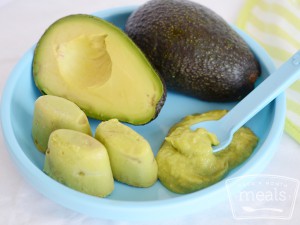For babies 6-9 months it’s recommended to start introducing real food! If it’s their first time experiencing solids, you’ll want to start out with runnier purees and work up to thicker ones as mentioned in our Early Start post. And while there is no one “right” food to start them on, you may want to begin with veggies since our natural inclination is toward sweeter foods like fruit. As you introduce each new food, you’ll want to wait a few days before introducing the next to keep an eye out for any allergic reactions like a rash, diarrhea, or vomiting. If you notice any of these adverse reactions, notify your pediatrician.
Tips and Tricks
 Once your little one has grown accustomed to the thicker purees you can even start introducing a baby mesh feeder if they have a hankering for some independence in exploring solids. A ripe piece of banana, avocado, or pear is great in these little gadgets. It can have quite a messy outcome, but most babies enjoy it. It can also be helpful to put chunks of frozen banana, breast milk, or baby food in a mesh feeder to help soothe the discomfort that comes with teething.
Once your little one has grown accustomed to the thicker purees you can even start introducing a baby mesh feeder if they have a hankering for some independence in exploring solids. A ripe piece of banana, avocado, or pear is great in these little gadgets. It can have quite a messy outcome, but most babies enjoy it. It can also be helpful to put chunks of frozen banana, breast milk, or baby food in a mesh feeder to help soothe the discomfort that comes with teething.
If your child is wanting to relieve you of the spoon you are using to feed them, you might want to have an extra on hand for them to play with or a small bath toy you can wash off easily after feeding time is done. Busy hands usually make for fewer interceptions between the bowl and their mouth. If your little one doesn’t take well to purees at all, you could also try little bits of soft finger foods, like ripe fruits or well-cooked veggies or pasta. Be sure to consult your pediatrician first though.

Baby Food Avocado Puree
Expand Their Taste Buds
For the 6-9 month age range, we have a bit more variety with purees. Once basics have been introduced, you can start venturing into various blends that will give your little one a whole new dimension of flavor to explore.
First Foods (6-9 months) Meal Plans
Our meal plans are broken up according to the season, too, so the most economical foods available can be used. Plus your little one can enjoy fun treats like peaches or blueberries in the dead of midwinter without it breaking the bank.
Perfect for tiny hands, these seasonal meal plans are a fun way to introduce some new textures and flavors.
More questions or ready to move on to the next stage?
To see what we’ve covered in the series already and what’s ahead check the links below!